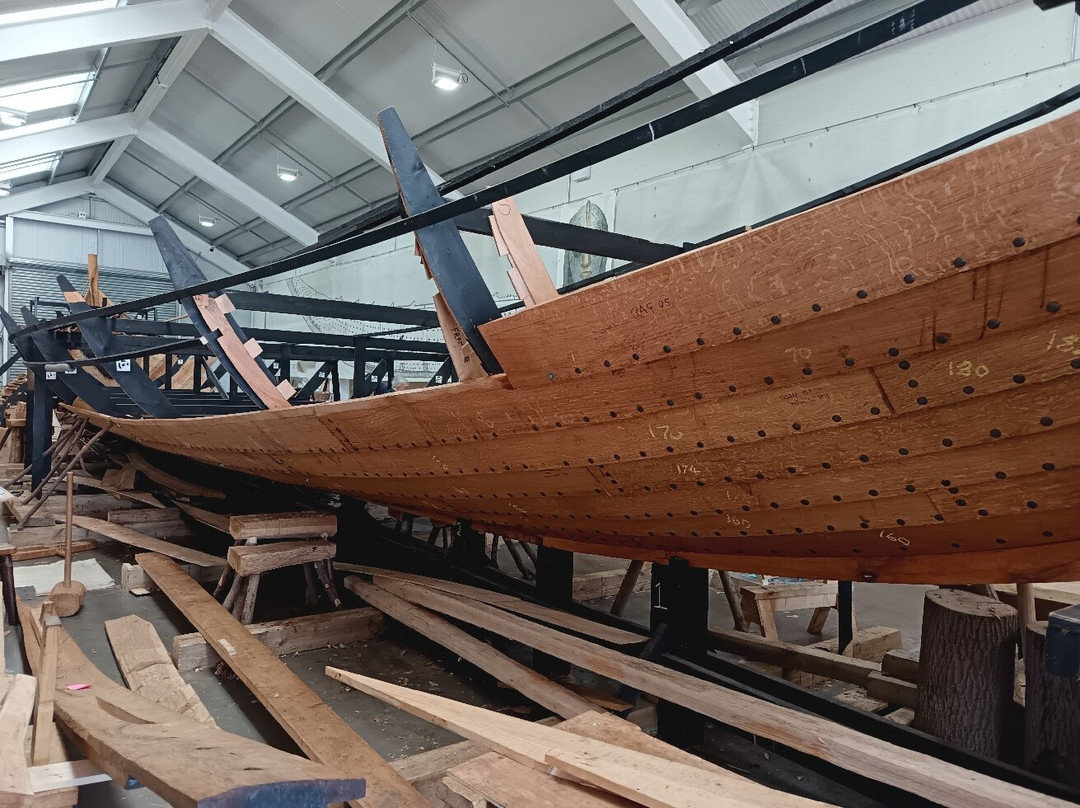的点评
A not-to-be-missed insight into age-old boat-building
The Longshed的点评
点评:So I am having a little jaunt on the train and joshing with a fellow bike rider about the state of her chain when the conversation turned to why we were both going to Woodbridge. I was heading for a talk about the weather and Natasha, doing her Master's in Medieval Architecture at Cambridge was heading to volunteer at the Saxon Ship project.
With three quarters of an hour to kill before my appointment, I decided to add the Sutton Hoo Ship's Company project, as it's called, to my itinerary. I'm glad I did.
How on earth do you turn huge oak trees into planks? How do you fix them all together? How do you stop a clinker-built vessel from leaking? How do they know it was propelled just with oars? Answer: They don't, because they don't have that bit of the ship at Sutton Hoo for reference. So the highly-skilled woodworkers, three Davids on the day I visited, use axes and other hand tools to re-create something very special indeed.
No entrance fee, which is extraordinary, so be generous with your donations. Visit their excellent website to learn a lot more.
Oh! My chat turned out to be about the Shipping Forecast, very much part of this ex-Navy man's life and something that Saxons and Vikings could well have done with for their passage across the North Sea.
With three quarters of an hour to kill before my appointment, I decided to add the Sutton Hoo Ship's Company project, as it's called, to my itinerary. I'm glad I did.
How on earth do you turn huge oak trees into planks? How do you fix them all together? How do you stop a clinker-built vessel from leaking? How do they know it was propelled just with oars? Answer: They don't, because they don't have that bit of the ship at Sutton Hoo for reference. So the highly-skilled woodworkers, three Davids on the day I visited, use axes and other hand tools to re-create something very special indeed.
No entrance fee, which is extraordinary, so be generous with your donations. Visit their excellent website to learn a lot more.
Oh! My chat turned out to be about the Shipping Forecast, very much part of this ex-Navy man's life and something that Saxons and Vikings could well have done with for their passage across the North Sea.
翻译:于是,我在火车上闲逛了一会儿,正和一位骑自行车的同伴聊着她的车链,这时话题转到了我们为什么要一起去伍德布里奇。我正要去聊天气,而正在剑桥大学攻读中世纪建筑硕士学位的娜塔莎正要去参加撒克逊船舶项目的志愿者工作。
离预约时间还有四十五分钟,我决定把萨顿胡船舶公司(Sutton Hoo Ship's Company)的项目(就像它的名字)加到我的行程里。我很高兴我这么做了。
你究竟是怎么把巨大的橡树变成木板的?你又是怎么把它们拼在一起的?你又是如何防止一艘用搭接料建造的船漏水的?他们怎么知道这艘船是用桨推进的?答案是:他们不知道,因为他们没有萨顿胡的那部分船可以参考。所以,技艺精湛的木工们——我去的那天,他们有三个大卫——用斧头和其他手工工具,重新创造了一件非常特别的东西。
免费入场,这很特别,所以请慷慨解囊。访问他们优秀的网站,了解更多信息。
哦!我的聊天内容竟然是关于航运预报,这在这位前海军老兵的生活中占据了很大一部分,也是撒克逊人和维京人穿越北海时很需要的东西。
离预约时间还有四十五分钟,我决定把萨顿胡船舶公司(Sutton Hoo Ship's Company)的项目(就像它的名字)加到我的行程里。我很高兴我这么做了。
你究竟是怎么把巨大的橡树变成木板的?你又是怎么把它们拼在一起的?你又是如何防止一艘用搭接料建造的船漏水的?他们怎么知道这艘船是用桨推进的?答案是:他们不知道,因为他们没有萨顿胡的那部分船可以参考。所以,技艺精湛的木工们——我去的那天,他们有三个大卫——用斧头和其他手工工具,重新创造了一件非常特别的东西。
免费入场,这很特别,所以请慷慨解囊。访问他们优秀的网站,了解更多信息。
哦!我的聊天内容竟然是关于航运预报,这在这位前海军老兵的生活中占据了很大一部分,也是撒克逊人和维京人穿越北海时很需要的东西。
旅行类型:独自旅行

此点评仅代表旅行者个人的主观意见,并不代表TripAdvisor以及其合作方的意见。
关于我们
|新闻动态
|商务合作
|会员中心
|业主中心
|常见问题
|意见反馈
|联系我们
|营业执照
© 2025 Tripadvisor 版权所有。
使用条款 |隐私政策 |网站工作原理
部分照片由 VFM Leonardo 提供。
* Tripadvisor不是旅行社,也不是旅游预订服务代理商。我们提供免费、客观、公正的旅游资讯服务。 (显示更多)
TripAdvisor LLC 既不是预订代理商,也不是旅游运营商,不会向网站用户收取任何服务费。 按照规定,在 Tripadvisor 发布机票价格、游览和旅行套餐的合作伙伴(航空公司、旅行提供商及预订代理商),其标价须包含所有费用和附加费用。 例如, 机场出入境税费、消费税与其他服务费、手续费、杂费及附加费用。 当您向我们的某个合作伙伴进行预订时,请务必查阅他们的网站以了解当地行政部门要求的所有适用费用的具体情况。 除非另有说明,机票价格通常指的是一个人的价格(以人民币计)。
为方便起见,TripAdvisor LLC 根据从我们的预订合作伙伴获取的空房率计算每个酒店的均价。 对于游览和景点来说,所显示价格通常是每位成人的最低可用价格。 对于列出的任何旅行套餐或优惠,TripAdvisor LLC 无法保证任何特定的费率或价格。 此外,酒店均价每晚会更新,并以您的首选币种表示(使用现行汇率)。 由于这些已换算的价格是预估价格,因此,有关具体金额和币种请与预订网站进行核实。
此外,TripAdvisor LLC 无法保证我们网站上宣传的价格随时有效。 标价可能需要预订一定天数才能生效,或有不可用日期、使用条件或限制。
TripAdvisor公司对外部网站的内容一概不负责。优惠价格中不含税和其他费用。
ICP证:沪B2-20200433
沪ICP备20013175号
 沪公网安备31010502005427号
沪公网安备31010502005427号鹰程信息技术(上海)有限公司
货币/国家及地区
¥CNY
中国

